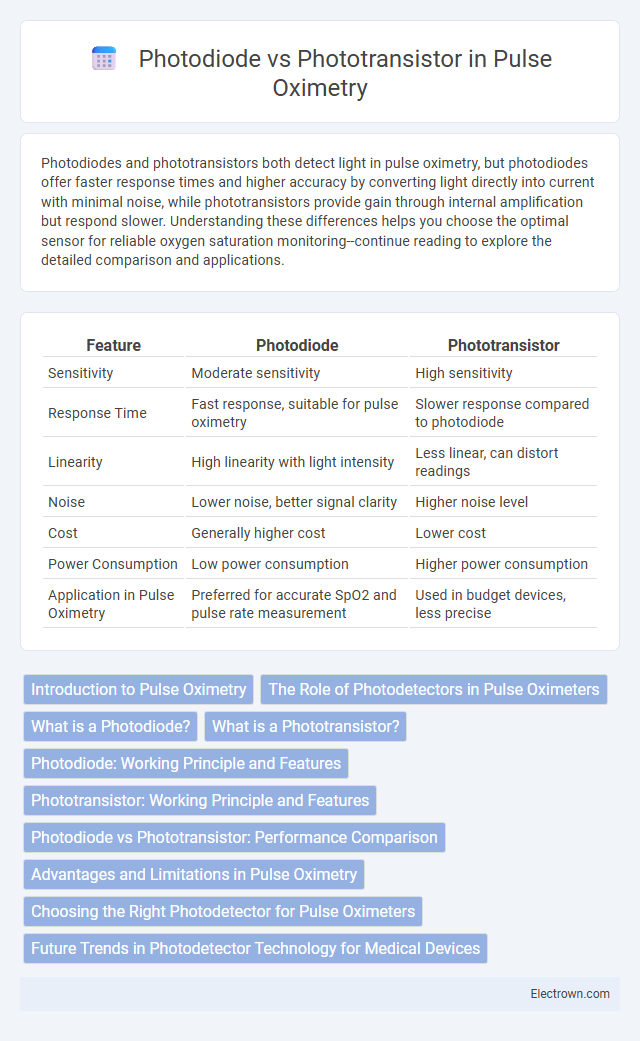Photodiodes and phototransistors both detect light in pulse oximetry, but photodiodes offer faster response times and higher accuracy by converting light directly into current with minimal noise, while phototransistors provide gain through internal amplification but respond slower. Understanding these differences helps you choose the optimal sensor for reliable oxygen saturation monitoring--continue reading to explore the detailed comparison and applications.
Table of Comparison
| Feature | Photodiode | Phototransistor |
|---|---|---|
| Sensitivity | Moderate sensitivity | High sensitivity |
| Response Time | Fast response, suitable for pulse oximetry | Slower response compared to photodiode |
| Linearity | High linearity with light intensity | Less linear, can distort readings |
| Noise | Lower noise, better signal clarity | Higher noise level |
| Cost | Generally higher cost | Lower cost |
| Power Consumption | Low power consumption | Higher power consumption |
| Application in Pulse Oximetry | Preferred for accurate SpO2 and pulse rate measurement | Used in budget devices, less precise |
Introduction to Pulse Oximetry
Pulse oximetry relies on sensors that detect changes in light absorption through blood, using photodiodes or phototransistors to measure oxygen saturation. Photodiodes offer faster response times and higher linearity, making them ideal for capturing rapid pulsatile signals in pulse oximetry. Phototransistors provide greater sensitivity and signal gain but have slower response times, which can affect the accuracy of oxygen saturation readings during dynamic measurements.
The Role of Photodetectors in Pulse Oximeters
Photodiodes and phototransistors serve as critical photodetectors in pulse oximeters by converting light signals into electrical signals to measure blood oxygen levels accurately. Photodiodes offer fast response times and high linearity, making them ideal for capturing rapid changes in light absorption caused by pulsing arterial blood. Your choice of photodetector influences the device's sensitivity and precision, with phototransistors providing higher gain but slower response, which may affect the oximeter's overall performance.
What is a Photodiode?
A photodiode is a semiconductor device that converts light into an electrical current, widely used in pulse oximetry for detecting variations in light absorption by blood. Its fast response time and linearity enable precise measurement of oxygen saturation by sensing red and infrared light transmitted through tissue. Unlike phototransistors, photodiodes offer higher accuracy and lower noise, making them essential for reliable pulse oximeter performance.
What is a Phototransistor?
A phototransistor is a semiconductor device that converts light into electrical current, acting as a light-sensitive transistor with internal gain, making it more responsive than a photodiode. In pulse oximetry, phototransistors amplify the detected light signal from the LED passing through tissue, improving sensitivity and signal strength. Their built-in amplification enables better detection of the pulsatile blood flow, crucial for accurate oxygen saturation measurements.
Photodiode: Working Principle and Features
Photodiodes in pulse oximetry operate based on the photoelectric effect, where they convert light into an electrical current proportional to the intensity of the absorbed light. Their fast response time and linearity enable accurate detection of light absorption changes caused by arterial blood oxygen levels. You benefit from photodiodes' high sensitivity and low noise, crucial for precise and reliable pulse oximetry measurements.
Phototransistor: Working Principle and Features
Phototransistors in pulse oximetry operate by converting light into an electrical current, amplifying the signal generated by the absorbed photons, which enhances sensitivity to low light levels from the LED light passing through the tissue. Their working principle relies on the base region controlling collector current, allowing them to detect variations in light intensity corresponding to blood oxygen saturation levels. Key features include higher gain than photodiodes, increased sensitivity, and slower response time, making phototransistors suitable for applications where weak signal detection is critical but speed is less paramount.
Photodiode vs Phototransistor: Performance Comparison
Photodiodes offer faster response times and higher accuracy in detecting light intensity changes, making them ideal for pulse oximetry where precise oxygen saturation measurement is critical. Phototransistors provide greater sensitivity due to internal gain but exhibit slower response and increased noise, which can reduce signal clarity in pulse oximetry applications. Choosing between a photodiode and a phototransistor impacts Your pulse oximeter's performance by balancing speed, sensitivity, and signal-to-noise ratio for reliable readings.
Advantages and Limitations in Pulse Oximetry
Photodiodes in pulse oximetry offer fast response times and high linearity, enabling precise measurement of changing light intensities crucial for accurate oxygen saturation readings. Phototransistors provide higher sensitivity and internal gain, enhancing signal detection in low-light conditions but may suffer from slower response and increased noise, potentially impacting real-time accuracy. Your choice depends on balancing the need for speed and precision with sensitivity and signal amplification in specific pulse oximetry applications.
Choosing the Right Photodetector for Pulse Oximeters
Choosing the right photodetector for pulse oximeters involves balancing sensitivity and response time, where photodiodes offer fast response and linear output ideal for accurate oxygen saturation measurements. Phototransistors provide higher sensitivity but slower response, which can introduce signal lag and affect real-time readings. Your pulse oximeter design benefits most from photodiodes when precise, rapid detection of red and infrared light absorption is critical for reliable SpO2 monitoring.
Future Trends in Photodetector Technology for Medical Devices
Emerging trends in photodetector technology for pulse oximetry emphasize enhanced sensitivity and miniaturization, with silicon photomultipliers and organic photodiodes showing promising improvements over traditional photodiodes and phototransistors. Advanced materials and nanostructures enable higher signal-to-noise ratios and lower power consumption, critical for wearable and continuous monitoring devices. Integration of smart photodetectors with AI-driven algorithms is set to revolutionize accuracy and real-time adaptive sensing in medical diagnostics.
Photodiode vs Phototransistor in Pulse Oximetry Infographic

 electrown.com
electrown.com